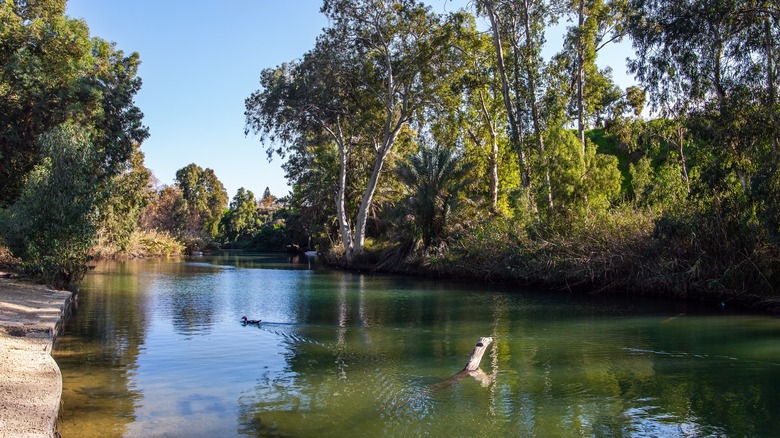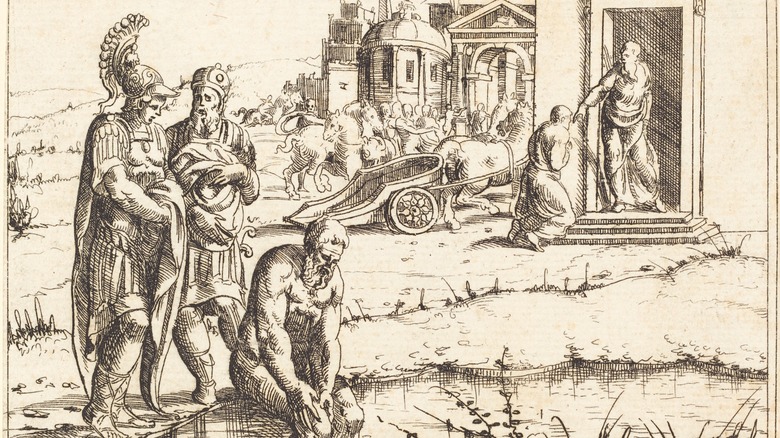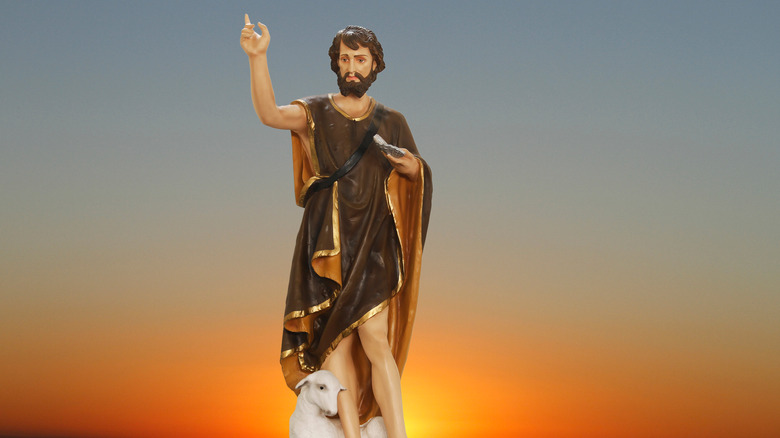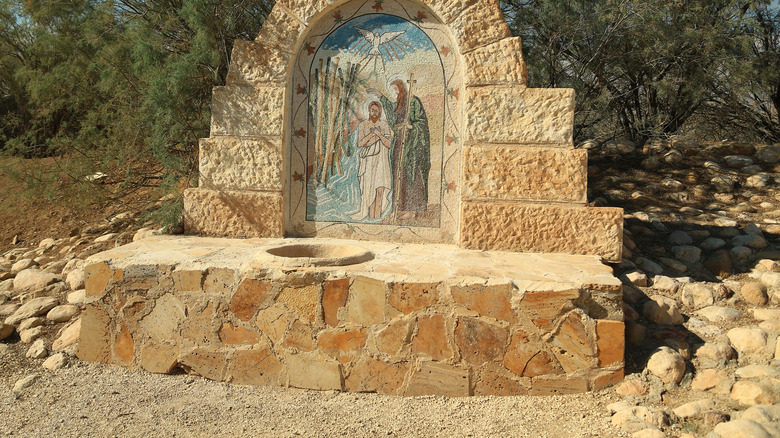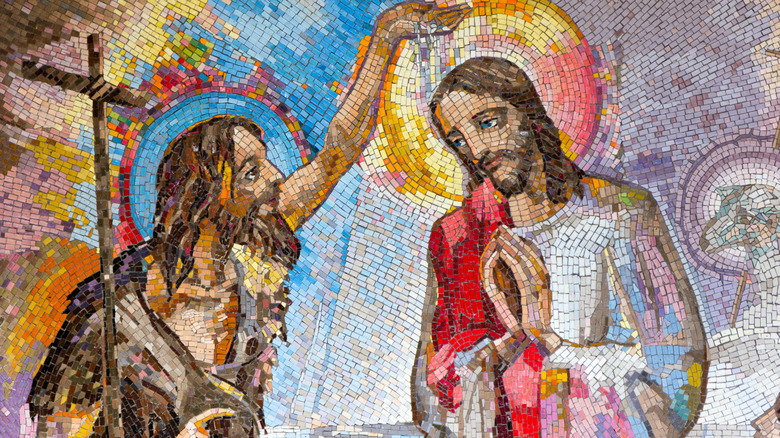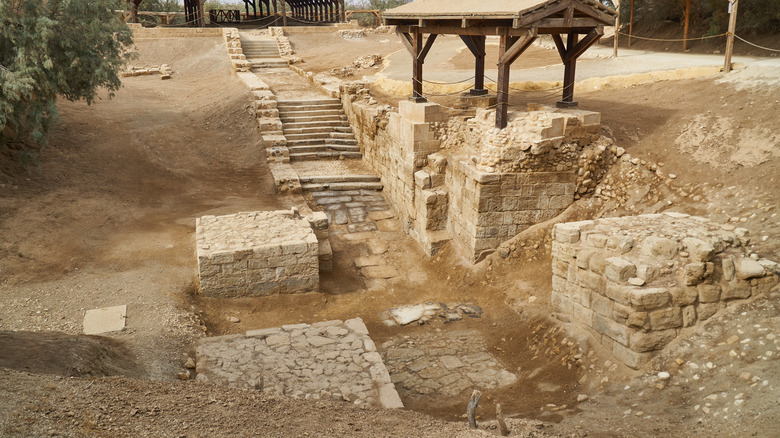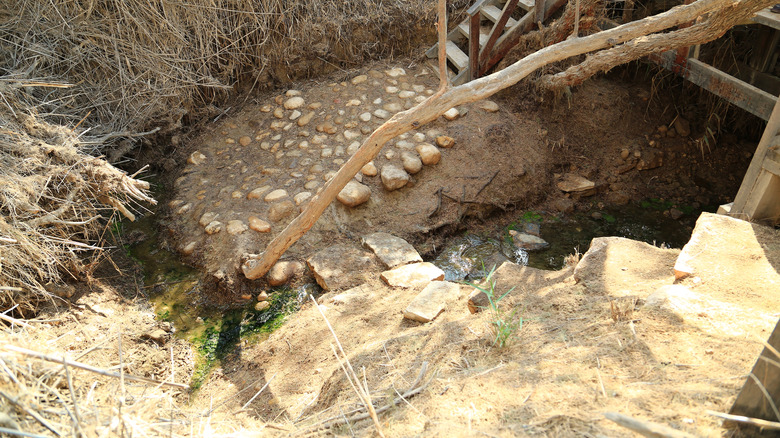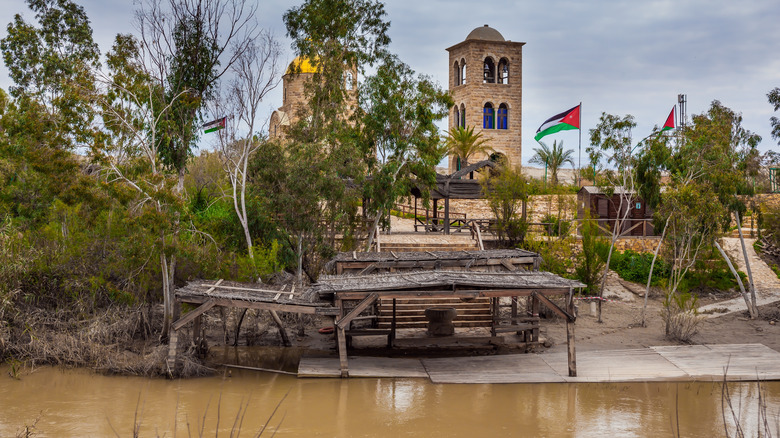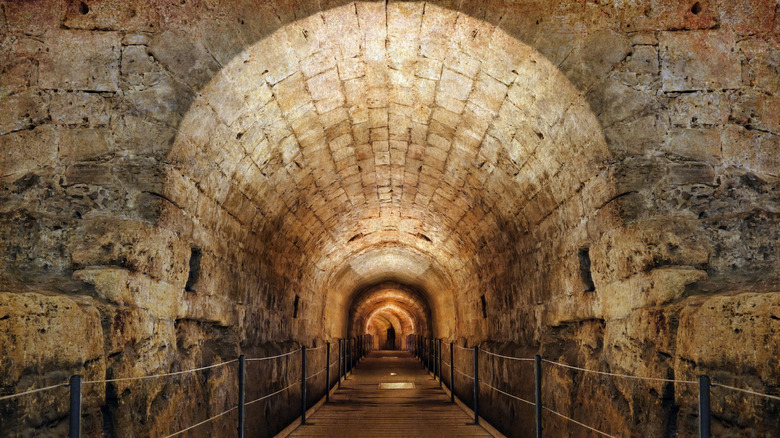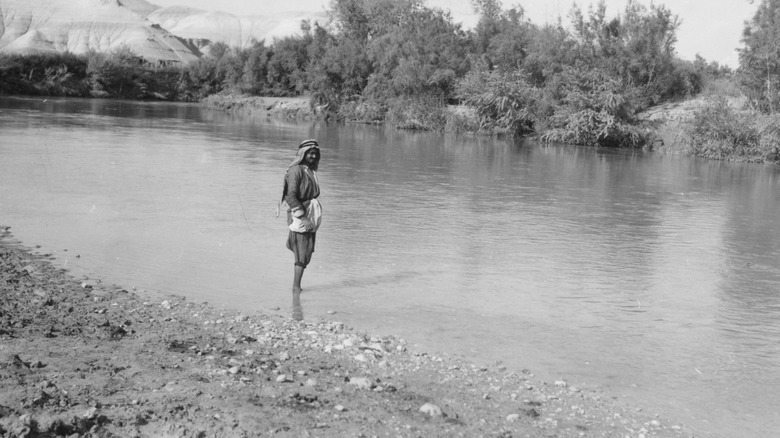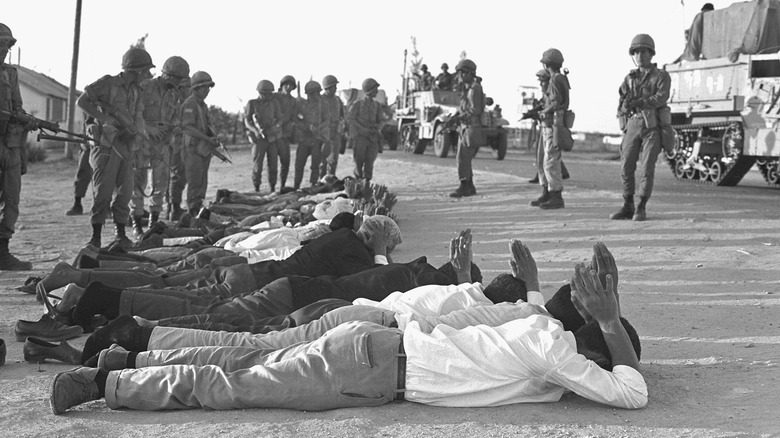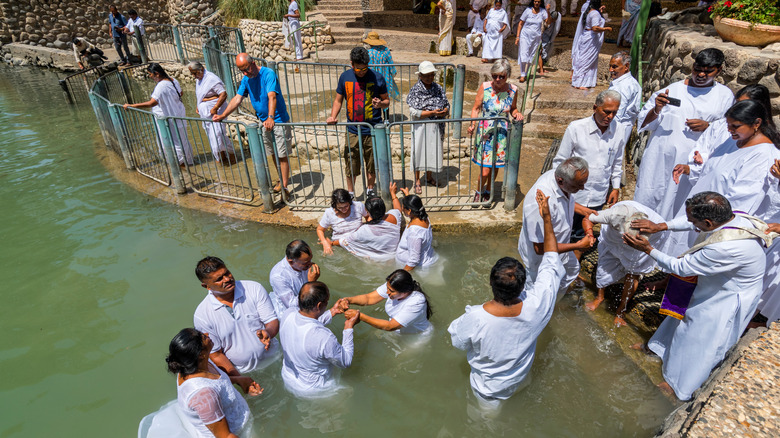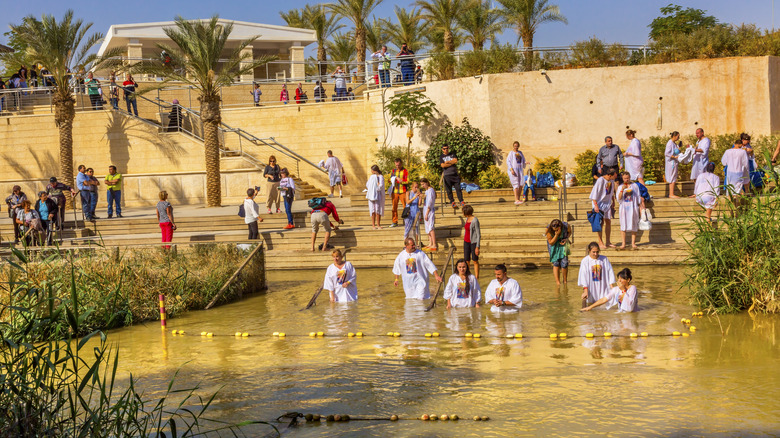The History Of Baptism In The Jordan River Explained
The Jordan River is one of the most culturally significant rivers in the world. The World Monuments Fund refers to it as "lay[ing] at the heart of millennia of history, religion, and culture," while acknowledging that multiple religions consider it holy. Jesus was baptized in the waters, several of Mohammed's followers are buried along the banks, and empires have risen, fallen, and often clashed on the east and west sides.
It's hard to do much more than that as a river. And geographically, its significance is no less important. Now serving as the eastern border of Israel, separating it from Jordan, the river flows from the Sea of Galilee down to the Dead Sea. In fact, it is such a significant body of water that both the nation of Jordan and the territory of the West Bank adopted their names from the river itself.
But most of all, the river is known for its baptisms. Nearly 1 million people are baptized in the Jordan annually (via OSU.edu), and while that stems from the baptism of Jesus, that's not the only history that the river has with the sacred rite of Christianity.
Here is the full history of baptism in the Jordan River.
There may have been a symbolic pseudo-baptism in the Old Testament
While baptism hasn't always been a tenet of Christianity, the notion of using water to purify the body goes way back, branching out into other religions and cultures dating back to the ancient Mesopotamians, according to Encylopedia.com. But the first time it reaches the waters of the Jordan isn't actually the baptism of Jesus but further back in the Old Testament. And while not an actual baptism, the parallels are definitely there to make this something of a pseudo-baptism.
The story goes, according to the Bible, that the Syrian army commander Naaman suffered from leprosy and, despite being an enemy of the Israelites, contacted the prophet Elisha for healing. Elisha told Naaman to wash himself seven times in the waters of the Jordan. This didn't sit well with Naaman, who thought any river would do, but after some convincing from his in-house advisors, he did go forward with Elisha's advice and washed himself in the Jordan seven times. To his surprise, he emerged a new man, cured, and singing the praises of the Christian God.
Again, while this isn't technically a baptism, Christiany.com defines baptism as turning from an old life to a new life in Jesus Christ. Which is almost exactly what happened to Naaman in the book of 2 Kings. As such, this may well be the very first baptism associated with the Jordan River, or at least the first time the waters of the Jordan are used to purify.
It is the site of many pre-Christ miracles and milestones
The waters of the Jordan themselves are more than a little sacred to Christianity and Judaism alike. As Naaman found out in his own reported experience, these waters have been the site of several other monumental happenings in the Bible, thus making them even more important than just as the site of so many baptisms.
For instance, when the Jews escaped captivity in Egypt, their promised land was on the other side of the Jordan (via Deuteronomy), making it the final step before their freedom. In the book of Joshua, the sacred Ark of the Covenant crossed the Jordan, stopping the flow of the river. And not far from the banks, the prophet Elijah supposedly ascended to Heaven in a flaming chariot.
Elijah's ascension is so revered that it earned its own holy site title, Elijah's Hill, alongside the spot where Jesus was baptized. All of this, again, adding to the holiness that stems from the river and its waters and making the waters themselves sacred in numerous religious denominations.
John the Baptist may have been influenced by the Essens
The nature of baptism itself began with the aptly named John the Baptist, known in the Bible for being the first to actually baptize Christians into the faith. According to Britannica, the rite of baptism didn't even take root until the Apostle Paul spoke of it, making John the Baptist the origin point for the practice.
John baptized in the Jordan River for a few reasons. First, it was such a sacred river to the faith. Second, John lived in the wilderness around the river. Third, that's where John was influenced into the foundations of baptism in the first place.
According to the Jerusalem Post, John lived close to the Essens, a Jewish sect that believed in the daily immersion of water to regain purity. Given that baptism wasn't yet an institution of Christianity until the foundation of the church itself, John's close association with the Essens is the origin point for his religious exploits in the Jordan, leading to what would become the most sacred of Christian rites.
The most likely location of Jesus' Baptism is Bethany Beyond Jordan
Given the historical context of Jesus Christ himself being baptized, it's important to factor in where specifically on the river, geographically, he was actually baptized. After all, the Jordan is a big river, and while baptisms have occurred all along the river on both banks, knowing the exact location has significance to several faiths so that disciples can follow in his footsteps and be baptized exactly where he was.
According to the UNESCO World Heritage site, that exact location is Bethany Beyond the Jordan, or "Al-Maghtas." It's here that the remains of numerous ancient buildings — churches, chapels, monasteries, and other places of worship — have been discovered with evidence of baptismal paraphernalia (via BBC). The remains of over 20 buildings have been found centered in this specific place which, again, is why it is strongly believed that this is where the crucial baptism took place.
Interestingly, due to the shrinkage of water in the river and the transformation of the river over the centuries, the bend where Jesus was supposedly baptized is now dry land, reports NPR, though no less sacred to the hundreds of thousands of pilgrims who make the trip each year.
Baptism only took root in Christianity after Jesus' baptism
There are few tenets in Christianity more universal across denominations than the ritual of baptism, so, it may seem like it's always been an institution of the faith. But it didn't really become a sacred rite until the baptism of Christ, according to Britannica. And it seems to pull together the established widespread ritual of immersion in water brought on by John the Baptist and the Essens, with the addition of Christian prayer, which appeared first with the Apostle Paul.
After John's immersion technique, the first mention of baptism comes from Jesus himself in the book of Matthew, when he instructs his disciples to go forth and baptize people in "the name of the Father, the Son, and the Holy Spirit." But according to Britannica, scholars believe that the full culmination of the rite of baptism came following the Apostle Paul practicing baptism using the immersion from John and the prayers that he himself brought, as seen in the book of Acts.
Whatever the case, it's clear that baptism as a ritual developed over time from the initial baptism of Jesus, evolving through his disciples until it was established as an institution following the founding of the actual church in the first century.
Baptism has been practiced in the Jordan since the fourth century
With the growth of the Roman Empire and the occupation of Israel in 63 B.C.E. (via Britannica), the challenges and persecutions of all sects of Christianity began. Baptism became a subversive act that the Romans wanted to stomp out, thus any baptisms around the Roman-occupied Jordan River slowed for a few centuries, until the Edict of Milan in A.D. 313 (via Khan Academy).
The Edict of Milan made Christianity legal in the Roman Empire and therefore also made baptism legal again. It was around this time when archaeological remains show the resurgence of Christian religious buildings around Al-Maghtas and the Jordan River, signifying the return of pilgrims and baptism to the waters where it had all begun.
Among the archaeological remains from the fourth century are churches, monasteries, and even caves of hermits who lived in the area, not unlike John the Baptist, who lived in the wilderness himself, as per UNESCO. But the primary evidence that baptism was back in the Jordan was what they found in and beneath the ruins of those churches.
The Romans and Byzantines constructed baptism pools and cisterns in churches
While the shells of centuries-old buildings don't inherently tell us that the rite of baptism had returned to the banks of the Jordan River, what was found under and within those churches did. The churches housed numerous baptismal pools and cisterns where the water of the Jordan would have supplied Christians with all they needed to perform this sacred rite (via UNESCO). One baptismal pool was even shaped like a giant cross.
While the practice of baptism differs across denominations even to this day, with some preferring full immersion and some preferring just the dribbling of water from a bowl or cistern, both can be found among the remains of the area, proving the presence of so many different denominations of Christianity along the banks, all eager to baptize their followers in the holy waters.
This, according to UNESCO, is all the evidence needed to prove how important baptism was to the early Christian church dating back to the fourth century, since they all came equipped with the resources to perform it with the waters of the Jordan River.
The place of baptisms moved to the Western Bank in the sixth century
Traditionally, baptisms had been held on both banks of the Jordan River, and to this day, it's disputed which bank is the proper bank (via NPR). But for a long stretch, baptisms were only taking place on the western bank, starting right around A.D. 614, when the Persians overtook Jerusalem. This, paired with a long history of earthquakes and floods in the area, lead to the cluster of archaeological remains.
According to the archaeological survey of the area, most Byzantine and Christian structures on the eastern bank began to fall apart at this point, since the Christians were cut off by the Islamic Sassanid Empire. From that period until centuries later, churches and other baptismal structures began to pop up primarily along the west bank to accommodate the number of people still wanting to be baptized where Jesus had been.
According to the actual historical site, the correct bank, if there is such a thing, is the east bank, but given the drying up of the exact spot Jesus was baptized, both banks have been used for pilgrims.
The Templars may have built a castle to protect pilgrims
Seeing as how the conflict in the Middle East has been raging for centuries, it makes sense that the area around the Jordan would be largely affected by that conflict, going back to the Romans and into the modern-day, with the debate still raging (via NPR). But another interesting chapter comes during yet another spike in the conflict in the Middle East — The Crusades.
The nature of the Crusades was to reclaim the Holy Land for Christianity, so of course there was going to be a lot of consideration around the Jordan River, now under occupation of Muslim leaders for centuries. During their brief occupation of the area in the 1100s, the Knights Templar and Hospitaller found their way to the holy site where Jesus was baptized. And while there is no archaeological evidence of the crusaders building anything in the area, Theoderic wrote (via "The Military Orders Volume I: Fighting for the Faith and Caring for the Sick") that Templars had built a series of castles protecting the road from Jerusalem to Al-Maghtas. All in an effort to allow Christian pilgrims safe travel to the holy site of baptism.
Of course, in the end, Muslims reclaimed the area, the Christian pilgrimage largely dried up again, and any castle that may or may not have existed there is still missing or nonexistent.
Baptism returned in the 1930s
During Muslim occupation — with a brief crusader interlude — the evidence of baptisms and even the presence of Christians at all is essentially a big void. The very last major archaeological note comes from the 1300s, when an Orthodox monastery was supposedly constructed, but by the mid 1400s, all mention of that disappeared as well (via UNESCO).
That being the case, it's safe to say that the baptisms in the Jordan slowed considerably under Muslim occupation of the river's major holy sites. Access to the traditional route of pilgrimage was closed off until Franciscan friars completed the first documented pilgrimage in centuries in 1641 (via the Latin Patriarchate of Jerusalem). But even that didn't lead to any significant resurgence.
The return of documented baptisms didn't reemerge in the area until the 1930s when, according to the Patriarchate, there are videos showing Christians being baptized in the river again. And it was on that spot that they began to purchase land to reconstruct the Christian hub.
In the Six-Days War of 1967, Israel reclaimed the river's baptismal sites
The Six-Days War in 1967 had immediate repercussions on the accessibility of baptisms in the Jordan. In a comprehensive victory, Israel managed to reclaim the Sinai Peninsula, the Gaza Strip, the West Bank, Golan Heights, and old city Jerusalem (via Britannica).
This victory gave Israel control of the West Bank for the first time in centuries, reports the Times of Israel. But the conflict itself left a scar on the area that didn't allow baptisms to return as quickly as it might have seemed. Both sides of the river were closed due to military conflict, preventing any baptisms, and due to the presence of thousands of land mines, even the end of the actual war didn't bring back the freedom to access the place of Jesus' baptism. While there's no exact count on the number of landmines in the area, some estimates range as high as 4,000, as per the Patriarchate of Jerusalem.
Israel moved baptisms to Yardenit in 1981
Fourteen years after the Six-Days War, Israel decided that, rather than dwell on where they couldn't have baptisms, they would instead focus more on where they could. And so, they moved the site of baptisms to Yardenit, about 65 miles north of Bethany Beyond Jordan, just down from the Sea of Galilee (via Newsweek). While this was never a historical site, it allowed for the safe return of baptism. Shops popped up selling the traditional white baptismal garbs, and unlike the closed-off areas, this location had fresher running water than the holier sites down south, reports the BBC.
Even though the landmines in the original baptismal site have been removed and the area reopened in the 21st century, Yardenit remains a baptismal site to this day, with Israel claiming up to 500,000 annual baptisms there alone.
According to BBC, Yardenit has a massive advantage in the total immersion baptismal market because of the cleanliness of the water. Just south, the river becomes saturated with waste and salination that's so polluted it probably would have left Naaman with leprosy. So, while Jesus wasn't baptized there, he also didn't have to contend with the modern river waste, making where he was baptized so special.
People are back to regularly being baptized on both sides
While conflict always seems to rage in the Middle East, a peace treaty between Jordan and Israel in 1994 and the arduous removal of all land mines thanks to the Halo Trust has reopened the major religious centers of the river as recently as 2018. Eight different denominations have returned to their holy buildings in the region, despite some of their churches and chapels still weathered by bullet holes from the war (via the Guardian).
And while Jordan and Israel still compete for tourists by pitting the East Bank vs. the West Bank, notes NPR, baptism in the original holy sites of the Jordan River is well and truly safe again. Upwards of a million people make the trip annually, and you can see plenty of famous people making the trip as well, including the likes of Demi Lovato and Mario Lopez.
